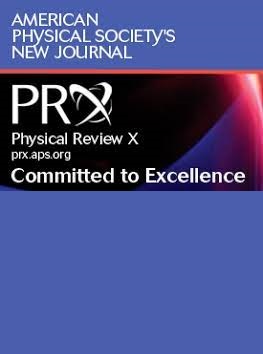Electrically Driven Cascaded Photon Emission in a Single Molecule
IF 15.7
1区 物理与天体物理
Q1 PHYSICS, MULTIDISCIPLINARY
引用次数: 0
Abstract
Controlling electrically stimulated quantum light sources (QLSs) is key for developing integrated and low-scale quantum devices. The underlying mechanisms leading to electrically driven quantum emission, however, are complex, as a large number of electronic states of the system can be involved and, thus, impact the emission dynamics. Here, we use a scanning tunneling microscope to electrically excite a model QLS, namely, a single ZnPc molecule, and disentangle the interplay of charge transfer and excited state formation. The luminescence spectra reveal two lines, associated to the emission of the neutral (exciton) and positively charged (trion) ZnPc, both exhibiting single-photon source behavior. In addition, we find a correlation between the charged and neutral emission, specifically, the signature of a photon cascade in which the radiative decay of the molecular trion is followed by the formation and decay of the exciton. By adjusting the charging vs discharging rate, we show that we can control these emission statistics. This generic strategy is further established by a comprehensive rate equation model comprising a variety of states that mediate excited state formation in the electrically driven single and cascaded photon emission process, revealing the complex internal dynamics of the molecular junction.单分子中的电驱动级联光子发射
控制电激量子光源是开发集成化、低尺度量子器件的关键。然而,导致电驱动量子发射的潜在机制是复杂的,因为系统的大量电子状态可能被涉及,从而影响发射动力学。在这里,我们使用扫描隧道显微镜电激发一个模型QLS,即单个ZnPc分子,并解开电荷转移和激发态形成的相互作用。发光光谱显示出两条线,与中性(激子)和正电荷(trion) ZnPc的发射有关,两者都表现出单光子源行为。此外,我们发现了带电和中性发射之间的相关性,特别是光子级联的特征,其中分子trion的辐射衰变之后是激子的形成和衰变。通过调整充放电速率,我们可以控制这些排放统计数据。通过一个综合的速率方程模型进一步建立了这一通用策略,该模型包含了在电驱动的单光子和级联光子发射过程中介导激发态形成的各种状态,揭示了分子结复杂的内部动力学。2025年由美国物理学会出版
本文章由计算机程序翻译,如有差异,请以英文原文为准。
求助全文
约1分钟内获得全文
求助全文
来源期刊

Physical Review X
PHYSICS, MULTIDISCIPLINARY-
CiteScore
24.60
自引率
1.60%
发文量
197
审稿时长
3 months
期刊介绍:
Physical Review X (PRX) stands as an exclusively online, fully open-access journal, emphasizing innovation, quality, and enduring impact in the scientific content it disseminates. Devoted to showcasing a curated selection of papers from pure, applied, and interdisciplinary physics, PRX aims to feature work with the potential to shape current and future research while leaving a lasting and profound impact in their respective fields. Encompassing the entire spectrum of physics subject areas, PRX places a special focus on groundbreaking interdisciplinary research with broad-reaching influence.
 求助内容:
求助内容: 应助结果提醒方式:
应助结果提醒方式:


